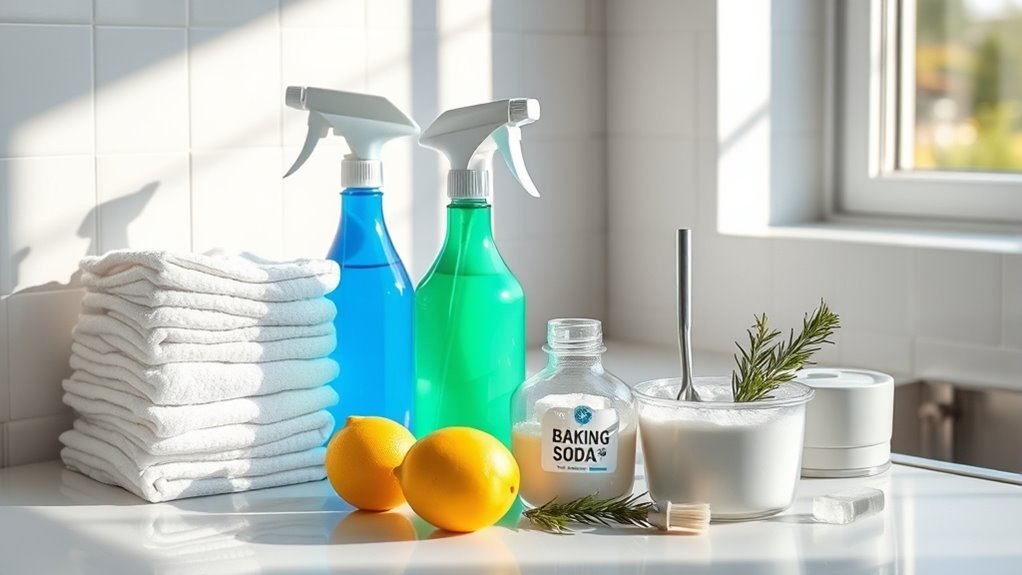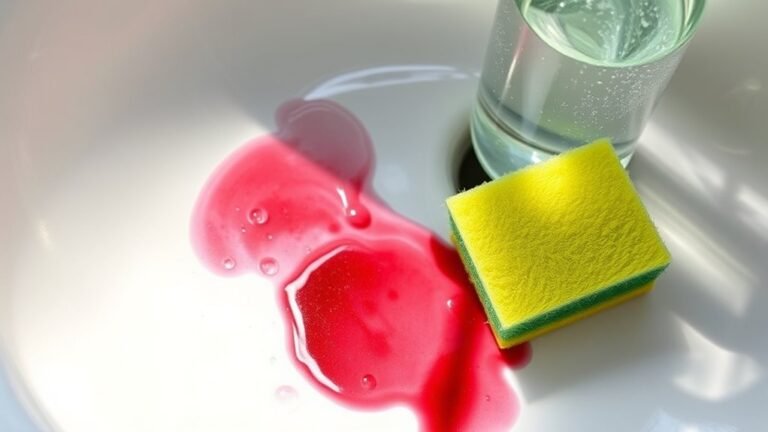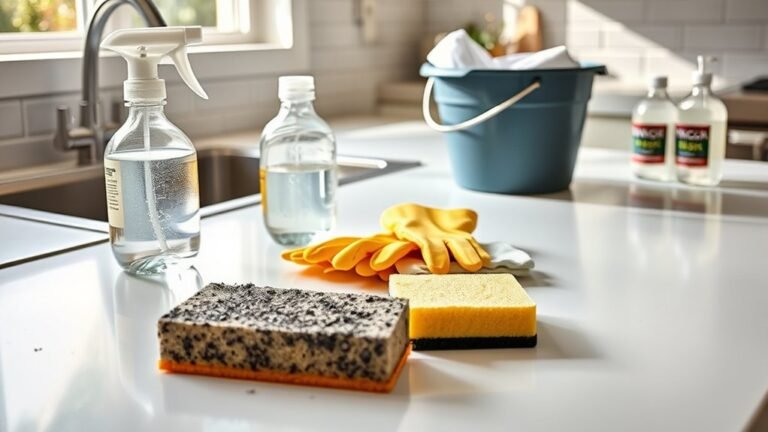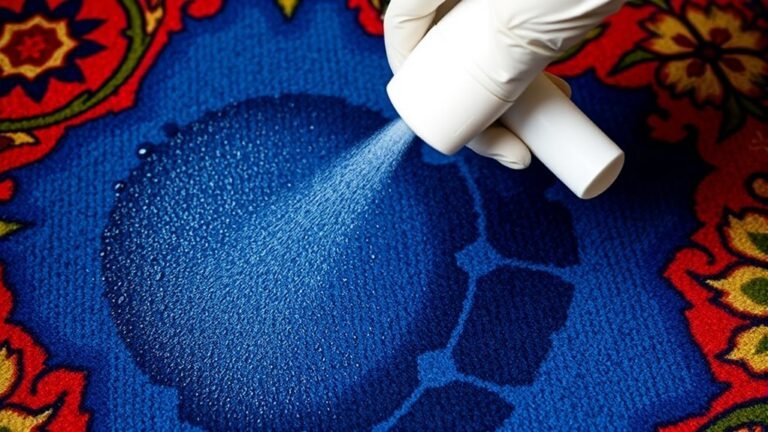How to Clean and Deodorize Your Kitchen
To clean and deodorize your kitchen, start by gathering eco-friendly cleaning supplies like microfiber cloths and natural detergents. Declutter and organize your countertops for easier cleaning. Wipe down appliances using soapy water or a baking soda paste for tough grease. Scrub and deodorize your sink with baking soda and vinegar, then refresh your garbage disposal the same way. Maintain trash bins carefully to avoid odors, and use natural deodorizers like essential oils or citrus peels to keep the air fresh. If you want more tips, keep exploring.
Gather Essential Cleaning Supplies

Before you plunge into cleaning, make sure you have all the essential supplies on hand. You want to work efficiently and freely without running back and forth looking for what you need. Gather your cleaning tools like scrub brushes, microfiber cloths, a sturdy sponge, and a mop or broom. Choosing eco friendly supplies not only helps protect the planet but creates a healthier kitchen environment for you. Look for biodegradable sprays, natural detergents, and reusable cloths. Having everything ready lets you move swiftly and confidently through your kitchen, reclaiming your space without feeling bogged down. When you rely on the right tools and green products, cleaning becomes less of a chore and more of a liberating ritual.
Clear and Organize Kitchen Surfaces
Once you’ve gathered your supplies, it’s time to clear and organize your kitchen surfaces. Surface decluttering frees up space, making your kitchen feel open and inviting. Start by removing everything from countertops and sorting items you use daily, occasionally, or rarely. This approach boosts your kitchen organization and helps you decide what stays or goes.
| Item Type | Keep Location | Action |
|---|---|---|
| Daily Use | Countertop | Keep accessible |
| Occasionally Use | Cabinet or Drawer | Store neatly |
| Rarely Use | Donate or Dispose | Remove completely |
Tackle Grease and Grime on Appliances

With your kitchen surfaces clear and organized, you can focus on tackling the grease and grime that build up on your appliances. Grease buildup on appliance surfaces not only looks messy but can also affect their performance. Start by unplugging your appliances for safety. Use a mixture of warm water and a few drops of dish soap to wipe down exterior surfaces, loosening that stubborn grease. For tougher spots, a paste of baking soda and water works wonders—apply it, let it sit for a few minutes, then scrub gently with a soft cloth or sponge. Don’t forget to clean buttons, handles, and knobs where grime often hides. Regularly maintaining these surfaces gives you freedom from sticky residues and keeps your kitchen appliances running smoothly and looking fresh.
Clean and Deodorize the Sink and Drain
Though the sink is one of the busiest spots in your kitchen, it’s often overlooked when it comes to cleaning. Keeping up with regular sink maintenance not only prevents buildup but also keeps your kitchen feeling fresh and inviting. Start by scrubbing the basin with a gentle cleanser to remove grime and stains. For drain cleaning, pour a mixture of baking soda and vinegar down the drain, let it fizz for a few minutes, then flush with hot water to clear blockages and eliminate odors. This simple routine frees you from stubborn clogs and unpleasant smells without harsh chemicals. By making sink and drain cleaning a quick, consistent habit, you maintain a kitchen space that’s clean, odor-free, and ready for whatever freedom your cooking brings.
Refresh and Sanitize Cutting Boards

Your cutting boards can hold onto stains and odors if you don’t clean them properly. Luckily, there are natural ways to remove stubborn marks and keep smells from building up. Let’s look at simple methods to refresh and sanitize your cutting boards effectively.
Removing Stains Naturally
If you’ve noticed stains lingering on your cutting board, don’t worry—you can refresh and sanitize it using natural ingredients. These methods free you from harsh chemicals while keeping your kitchen safe and clean.
- Sprinkle baking soda generously over the stained areas.
- Pour a vinegar solution (equal parts vinegar and water) onto the baking soda; it will fizz and lift stains.
- Let it sit for 5-10 minutes, then scrub gently with a sponge or brush.
- Rinse thoroughly with warm water and dry completely to prevent moisture damage.
Using this natural approach, you maintain your cutting board’s freshness without restrictions, embracing a clean kitchen with freedom and ease.
Preventing Odor Buildup
Stains aren’t the only issue cutting boards face; odors can build up over time, making your kitchen less inviting. To prevent your cutting board from becoming an odor source, clean it immediately after use. Rinse off any food residue, especially after handling pungent ingredients like garlic or onions. Regularly sanitize your board by wiping it with a mixture of white vinegar and water or a sprinkle of baking soda, which neutralizes odors without harsh chemicals.
Avoid storing food directly on your cutting board for extended periods, as this can trap smells and bacteria. Instead, use proper food storage containers. Keeping your cutting board dry and aired out between uses is another simple step toward cleanliness. By rejuvenating and sanitizing your cutting board regularly, you maintain a clean, odor-free kitchen environment that supports your freedom to cook confidently.
Remove Stains From Countertops and Cabinets
Although countertops and cabinets are designed to withstand daily use, spills and splatters can leave stubborn marks that dull their appearance. To keep your kitchen looking fresh, it’s important to treat stains according to the specific countertop materials and cabinet finishes you have.
- Identify the surface type—granite, laminate, wood, or painted—and choose a cleaner that won’t damage it.
- Use a gentle, non-abrasive cleaner for sealed surfaces; avoid harsh chemicals on natural stone or delicate finishes.
- For persistent stains, apply a paste of baking soda and water, letting it sit before wiping gently.
- Always test cleaning solutions in an inconspicuous spot to protect your kitchen’s freedom from damage.
Eliminate Odors From the Refrigerator
Keeping your countertops and cabinets spotless is just one part of maintaining a fresh kitchen. To truly freshen up your space, you’ve got to tackle the fridge next. Start by removing everything and checking for expired or spoiled items—these are the main odor sources. Wipe down all surfaces with a mixture of warm water and baking soda to neutralize smells without harsh chemicals. For lasting freshness, improve your fridge organization: store strong-smelling foods in airtight containers and keep raw meats separate to prevent cross-contamination. You can also place an open box of baking soda or activated charcoal inside to absorb lingering odors. With a few simple steps, your fridge will stay clean, smell fresh, and give you the freedom to enjoy your kitchen without unwanted stinks.
Clean and Deodorize the Garbage Disposal
Your garbage disposal can quickly develop odors if it’s not cleaned regularly. Using natural cleaning agents like baking soda and lemon can freshen it up without harsh chemicals. With a few simple deodorizing techniques and routine maintenance tips, you’ll keep it smelling clean and working smoothly.
Natural Cleaning Agents
A simple way to freshen and clean the garbage disposal involves using natural ingredients you probably already have at home. These natural cleaning agents let you maintain your kitchen’s freshness without harsh chemicals, giving you freedom from toxins while enjoying effective results. Here’s how to harness their power:
- Sprinkle baking soda inside the disposal to neutralize odors and lift grime.
- Pour white vinegar over the baking soda; the fizzing reaction breaks down buildup thanks to vinegar benefits.
- Let the mixture sit for 10-15 minutes to deeply clean the blades and drain.
- Flush everything with hot water to rinse away loosened debris and leave a clean, fresh disposal.
Using these natural agents keeps your kitchen clean while embracing a safer, eco-friendly approach.
Deodorizing Techniques
After using natural cleaning agents to tackle grime and buildup, you’ll want to focus on deodorizing the garbage disposal to keep your kitchen smelling fresh. Start by pouring half a cup of baking soda directly into the disposal. Baking soda neutralizes odors without harsh chemicals, giving you that clean freedom. Next, add a few drops of your favorite essential oils—lemon or eucalyptus work wonders for a revitalizing scent. Follow with a cup of vinegar; the fizzing action helps lift lingering smells and debris. Let it sit for 10-15 minutes, then flush the disposal with hot water while running it. This simple technique keeps your garbage disposal odor-free, so you can enjoy a kitchen that feels open and inviting—without relying on artificial sprays or overpowering scents.
Routine Maintenance Tips
Although it might seem like a small appliance, the garbage disposal needs regular care to function smoothly and stay odor-free. Incorporating it into your kitchen organization and cleaning schedule guarantees freedom from unpleasant smells and clogs. Here’s how you can maintain it easily:
- Run cold water before and after use to flush debris.
- Grind small citrus peels weekly to deodorize naturally.
- Avoid putting fibrous or starchy foods down the drain to prevent buildup.
- Use ice cubes to clean the blades and dislodge stuck particles monthly.
Maintain Freshness in the Trash Area
Since your trash area is a hotspot for odors and bacteria, keeping it fresh is essential for a pleasant kitchen environment. Effective trash management starts with regularly emptying your bins before they overflow. Use sturdy liners to prevent leaks and spills that cause lingering smells. Rinse your trash cans frequently with a mixture of warm water and mild detergent to eliminate residue buildup. For odor prevention, keep the lid closed tightly to limit airborne smells and avoid attracting pests. Consider placing your trash bin in a well-ventilated spot to reduce moisture and slow bacterial growth. By staying on top of these simple steps, you’re ensuring your kitchen stays inviting and free from unwanted odors, giving you more freedom to enjoy your space without hassle.
Use Natural Deodorizers for a Pleasant Scent
Keeping your trash area fresh plays a big role in reducing kitchen odors, but to create an inviting atmosphere, you’ll want to add natural deodorizers. These simple, free-spirited solutions help you enjoy a pleasant scent without harsh chemicals. Here are four easy ways to keep your kitchen smelling great:
- Sprinkle baking soda at the bottom of your trash can to neutralize odors.
- Use a few drops of essential oils like lemon, lavender, or eucalyptus on cotton balls and place them around the kitchen.
- Simmer a pot of water with citrus peels and herbs to naturally freshen the air.
- Fill small jars with activated charcoal, which absorbs unwanted smells effectively.
Embrace these natural options and breathe easy in your fresh, free kitchen.
Frequently Asked Questions
How Often Should I Deep Clean My Kitchen Appliances?
You should deep clean your kitchen appliances every 1 to 3 months to keep things running smoothly. Sticking to a consistent kitchen cleaning frequency helps prevent buildup and extends appliance life. Quick appliance maintenance tips include wiping spills immediately and checking seals regularly. This way, you’ll save time and stress, giving you more freedom to enjoy your space without worrying about unexpected breakdowns or lingering odors.
Can I Use Vinegar to Clean Stainless Steel Surfaces?
Using vinegar to clean stainless steel surfaces is like a refreshing change for your kitchen—it’s effective and natural. Vinegar effectiveness lies in its ability to cut through grime and leave a streak-free shine. For stainless steel maintenance, just dilute vinegar with water, apply it with a soft cloth, and wipe gently. You’ll enjoy a sparkling finish without harsh chemicals, giving you the freedom to keep your space fresh and eco-friendly.
What Is the Best Way to Clean Kitchen Tile Grout?
When it comes to grout cleaning, you’ll want to mix baking soda and water into a paste and apply it to the grout lines. Let it sit, then scrub gently with a toothbrush or grout brush. For stubborn stains, add a bit of vinegar. This simple method keeps your tile maintenance easy and effective, giving you freedom from harsh chemicals while keeping your kitchen tiles looking fresh and spotless.
How Do I Safely Clean Kitchen Exhaust Fans?
You might worry that cleaning kitchen exhaust fans is too complicated or risky, but it doesn’t have to be. For safe cleaning, first unplug the fan and remove the cover. Soak the parts in warm, soapy water to loosen grease. Use a soft brush for stubborn grime, then dry completely before reassembling. Regular exhaust fan maintenance like this keeps your kitchen fresh and gives you freedom from smoky air and potential fire hazards.
Are There Any Quick Tips for Preventing Mold in the Kitchen?
To tackle mold prevention, you’ll want to focus on moisture control first. Keep your kitchen dry by wiping up spills right away, and use a dehumidifier or exhaust fan to reduce humidity. Don’t let wet sponges or dishcloths sit around—they’re mold magnets. Also, make sure your sink and pipes aren’t leaking. With these quick steps, you’ll enjoy a fresher kitchen without feeling tied down by constant cleaning chores.






